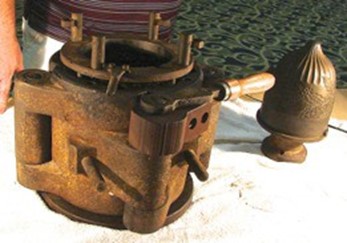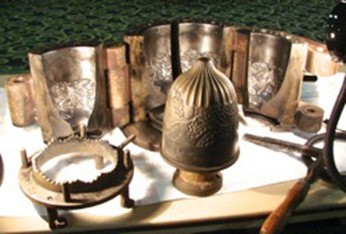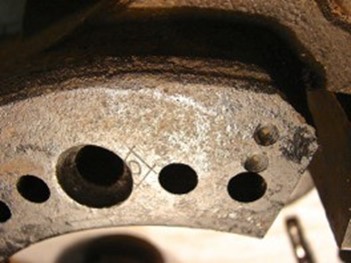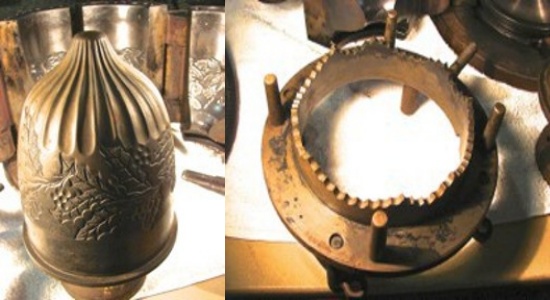The History of the Christmas Compote Mold
by Barb Chamberlain
Several years ago, in 1997, Dr. James S. Measell, noted glass historian, Bud Ward, retired foreman of the Hot Metal Department at Fenton, and David E. Richardson, then publisher of Glass Collector, were working in a warehouse filled with rows of old glass molds documenting the molds that were found there. I’m sure it was an exciting job trying to determine the pattern, shape, condition and workability of each old, hard to open mold. As Dr. Measell and Bud determined the aforementioned, they would report their findings to David, and he recorded each recognizable mold.
Determining the patterns required them to recognize the patterns in the reverse fashion, looking at the plunger (the part that determined the interior pattern) and the three or four-‐part mold used to mold the exterior pattern of each pressed glass piece.
The trio eventually came across a very large and heavy mold. They managed to rotate it so they could use a rubber mallet to deliver a few well-placed blows to attempt to open the mold. At first it opened a slight way, and using a flashlight, Dr. Measell could peer inside. He saw some leaves and berries. Bud was able to identify the shape as a large, pedestaled piece. They noticed scallops on the top ring. The plunger, of course, was still inside, and Dr. Measell noticed holly leaves and berries on it, as well. They were anxious to see the mold opened fully, so Bud gave the mold a few more thumps with the rubber hammer. As it opened, they were excited to see that it was indeed the Christmas Compote mold.
The closed mold which was discovered inside the warehouse that cold winter day is pictured above. The plunger, right, was inside the mold at the time of discovery.
Shown above is what Measell, Ward, and Richardson found as the mold was pried open. It shows the four-part mold which produced the exterior pattern, rear, the ring used for the top edge treatment of fluting, left, and the plunger which created the interior design, center.
Previously, collectors had speculated on the maker of this large, beautiful piece of glass, which had never been marked. Some had speculated that either Northwood or Millersburg produced this magnificent piece of glass. With scrutiny, the trio found two maker’s marks on the top edge of the mold a D in a diamond mark, which means, of course, that it was a product of the Dugan Glass Company. This mark was introduced in 1906 by Dugan (although their carnival production didn’t begin until several years later).
The D in diamond mark is shown on the top edge of the mold in two places. This would not have been included on the glass piece that was molded because this was where the ring that produced the top edging was attached to the mold.
The above photo shows two sections of the four-part mold that was used to form the exterior of the Christmas Compote. This would be the reverse image since the mold maker would have had to carves into the metal mold to produce the raised pattern on the glass.
Above to the left is the plunger which was inserted into the mold when exactly the correct amount of molten glass had been placed in the mold. The amount of molten glass had to be perfect to produce a clear pattern with little to no oozing of glass. The top ring, above on the right, was then secured to the mold. When the piece was removed from the mold, a wooden paddle was used to flare and flatten the top edge.
Old Christmas Compotes have been found only in purple and marigold. Purple might be a bit easier to find, but neither color is prevalent.
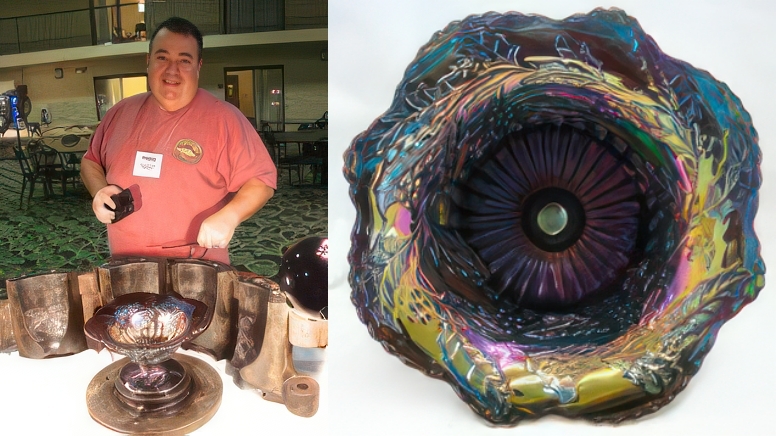
To show the size of the mold and how the compote came from the mold, Todd Kuwitsky shared the Christmas Compote which he brought to the convention. The picture on the right shows interior of the compote is what is formed by the plunger, which had also been carved into the mold to produce the raised pattern on the glass.
David Richardson bought the mold and arranged to have mold samples produced in the summer of 1997 by the Fenton Art Glass Company. There were fourteen mulberry blue (one of which was not iridized), three iridized teal, and one iridescent topaz opalescent compotes made at that time. These were marked with GP, for Glass Press, and a script F (this was the mark Fenton used if they were using a mold that was made for a different glass company).
Later Fenton used this mold to produce other colors than those listed above in limited runs—aqua opal, blue, celeste blue (perhaps the teal color), green opal, ice green opal, red, topaz opal (possibly vaseline opal was the same), and vaseline. They even produced a few whimseys—some into square shape, crimped edges, banana dish shape, fan vase, a spittoon vase, handled basket and probably a few other novelty shapes. Richardson promised never to make the original two colors of purple and marigold.
Fast forward a few years.
The mold had not been used for years because many of the glass workers were having trouble removing this large glass piece from the mold without damaging the piece. An opportunity arises—Fred Stone and Brian Pitman had the opportunity to purchase this magnificent mold from Dave Richardson. Fenton continued to store the mold. When Fenton closed, people or clubs that had their molds stored at the factory-made arrangements for the molds to be in the hands of the owners. Eventually, the Christmas Compote mold made its way to Sue Fenton in Springfield, MO for storage. This year before the Woodsland convention, Brian arranged for Mitchell Stewart to pick up the mold and bring it to the convention.
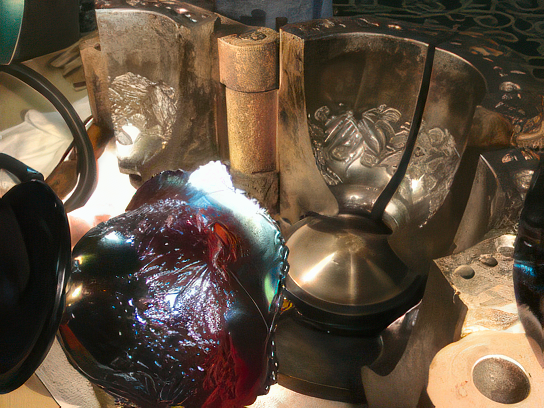
To show the reverse of pattern to glass, the compote was tipped sideways to the center two panels of the mold. See the photo above.
A nice seminar showing the mold was presented by Brian to the attendees. It took two or three people to lift the mold from Mitchell’s vehicle and set it on the luggage carrier. The mold weighs somewhere around 250 pounds or more, with the plunger weighing approximately 60 – 70 pounds.
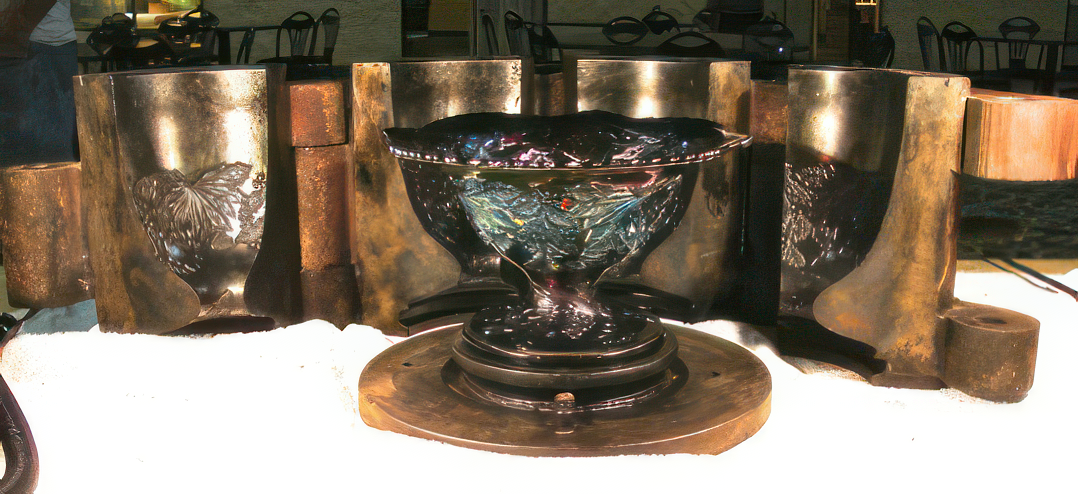
The majestic Christmas Compote sets proudly in the position of honor on the base of the mold. Many steps were required to produce this fantastic piece of glass.
Source: Glass Collector’s Digest, Volume XI, Number 3, October/November 1997
This article first appeared in the ICGA Pump in the December 2015 issue and is reprinted with permission.

